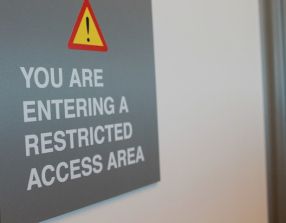 U.S. gross domestic product is among the world’s most closely watched numbers, an economic indicator that moves markets, makes headlines and affects countless government and private decisions. Special vigilance is required to ensure no one can steal, influence, or even accidentally overhear the latest GDP stats before they’re publicly released.
U.S. gross domestic product is among the world’s most closely watched numbers, an economic indicator that moves markets, makes headlines and affects countless government and private decisions. Special vigilance is required to ensure no one can steal, influence, or even accidentally overhear the latest GDP stats before they’re publicly released.
So how does the Bureau of Economic Analysis safeguard its data in the making?
We follow strict, long-standing security procedures. Some of these practices – disabling communications lines, locking staff up for hours, a rule of silence – may sound like the stuff of spy novels. They’re designed to ensure no one gets an unfair jump on information that belongs to all Americans equally.
These policies also help maintain confidence in the objectivity of BEA’s work. We are a nonpolitical agency composed entirely of career employees. Our rules maintain clear separation between the calculation and policy-neutral release of BEA’s data and the interpretation of that data by policymakers and other political figures.
The most dramatic-sounding element of our security is the monthly “GDP lock-up.”
Here’s a look at lock-up procedures and other precautions leading up to each month’s GDP report:
As the feeder numbers for GDP begin coming together, restrictions are placed on the staff of BEA’s National Economic Accounts Directorate. Access to areas where they keep their work is restricted. Most see only compartmentalized segments of data; only an essential few have access to enough pieces to assemble the GDP estimate.
Key players, including BEA executives and staff whose expertise is necessary for the final review, begin to turn their focus to the estimation. They are forbidden from speaking about this work with anyone outside BEA.
On the eve of the public release of the GDP report, BEA’s leaders and designated staff sign into a specially designed suite of secure rooms in our Suitland, Md., headquarters, where they will be “locked up” to review the final numbers. Internet connections in the suite are disabled, cellphones are taken away, the windows are covered. The lock-up manager controls a single phone to check for emergency voicemail messages from the outside world; if the manager delivers any messages to participants the contents will be retained in a security log. Another lock-up custom: The final GDP estimate is never spoken aloud.
Each component of the GDP estimate is presented for approval by the bureau’s leaders during lock-up. Once the estimate is approved and finalized, staff members draw up the necessary documents and computer files. That includes the news releases, graphs, and technical notes to be published on BEA’s website the next morning. Then the electronic documents are secured; paper copies of the final documents also are made and locked away. Even notes and doodles scrawled during the process are turned over to the lock-up manager for safekeeping. The staffers are held inside the suite for three hours or more, staying at least until 6 p.m., after the closure of U.S. financial markets.
Once employees have signed out of lock-up, they are forbidden from talking or communicating about the estimates with anyone until the numbers are officially released. An exception: Under federal law, once the GDP report has been finalized, an advance copy is relayed to the U.S. president, via the chairman of the Council of Economic Advisers.
The final steps in the process ensure that GDP data is released at precisely 8:30 a.m. Eastern time to all interested members of the public.
On the morning of the release, another lock-up facility comes into play, this time for members of the news media who get access to the GDP report one hour before it goes public. Giving them time to digest the new numbers before publishing fosters better accuracy in the first wave of news coverage, improving the public’s understanding of the data.
The journalists, representing credentialed news organizations, gather at the U.S. Department of Labor’s headquarters in Washington at 7:30 a.m. They must agree to abide by the media lock-up rules (posted on Labor’s website). That means no cellphones, handheld electronics or calculators, even coats or handbags, come into the room. Journalists sit at specially designed work stations that control their access to outside communications. They have 60 minutes to study the numbers and write their stories. If they have questions about the data, a BEA expert is there to help. At precisely 8:30 a.m., electronic connections to their workstations are restored and they post their stories to the public.
Meanwhile, back at BEA, the final GDP release files are delivered at 7:45 a.m. to the bureau’s web team, who gather in their own specially designed room in Suitland. The web team systematically codes and processes each of the files on two computers simultaneously, so they have an emergency backup. At exactly 8:30 on an official atomic clock, the team publishes to the web.
Once its numbers are out, BEA embraces openness. In addition to detailed data tables, we publish our statistical methodologies and assumptions. That allows outside economists to replicate GDP estimates, providing an independent check on the credibility and accuracy of our work.
Similar procedures are used to ensure the security and integrity of BEA’s other principal economic indicator releases. The latest security memo describing these policies is on BEA’s website.
BEA’s security procedures follow the standards of the U.S. Office of Management and Budget, as described in the OMB’s directive on release of economic indicators.